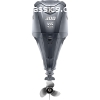dlatshaw asked, "So just post that info to this thread? I have 2 65 1000s and a 68 1000. The 68 is original AFAIK but not sure of the twins."
Yes,...That way when someone is looking for a wiring clarification they don't need to remember that it was covered under a compression related post.

This is one seriously long ‘write-up’ completed with the intent to assist and send home the importance of being VERY CAUTIOUS when working on the wiring in these classic Mercs.
AND,…I’ll bet that I may have made an error or omission or two in this write-up, so please wait for it to be reviewed for a few days by some of the forum’s Masters as I have been ‘spanked’ before.

Here we go!!!
Be sure and either carefully identify what color wire goes where from the internal harness plug to each specific component, or snap a few clear pixs.
Unless you have the control box open (which can be a 'Pandora's Box for a first timer for sure),…
1) Disconnect the external harness plug-in from the engine,
2) Connect the battery to the large red (+) battery cable and the large black (-) battery cable. If the battery cables are both black, do a continuity test between each of the two large pin holes to each black battery cable. The top large pin hole is positive (+), the bottom large pin hole is (-)
Remember to be holding the external plug in a proper position so that you are definitely looking at it correctly & not upside down while identifying the (+) & (-) large pin holes in the plug-in.
DANGER: The small wire colors can really throw a wrench into things if connected to the wrong place.
Example,...a small 12vdc (+) wire can be red, black, green, purple, or white depending on which harness you are using.
3) Once you have the battery connected,
But not plugged into the motor,
And with the key still 'OFF':
Test for 12vdc by holding your black (-) test lead to the bottom large pin hole and the red (+) test lead to the top large pin hole. You should see a 12vdc reading.
Leaving the black test lead in the (-) large pin hole,...Test each small pin hole with the red test lead for 12vdc. There should not be any small pin holes that show a 12vdc+ result.
4) Disconnect the Battery leads.
5) Now switch your meter to do an OHMS test.
6) With the black test lead still in the bottom large (-) pin hole,
And the ignition switch in the ‘OFF’ position,
Touch the red test lead to each of the small pin holes.
You may find one small pin hole that has continuity – or – you might NOT find one small pin hole that shows continuity.
7) Now,…ONLY if you had continuity between one small pin hole and the bottom large pin hole:
Turn the ignition key to "ON" with your test leads still connected to the same pins and the continuity should vanish.
Do NOT do Step #7 if you did not have continuity in Step #6.
Note: If you have continuity in Step #7,..This would be the circuit to 'kill' the motor's ignition on the magneto, Lightening Energizer, and Alternator Driven Ignitions (adi).
The ‘KILL’ wire color could be either Salmon, White, Orange, Blue, or Black with a yellow stripe.
Other ignition styles may not have this 'kill' circuit used in the ignition so your original plug-in harness may not have a small pin hole that has a small hole with no brass contact or wire molded into the plug-in.
8) Disconnect your test leads and turn your meter back to test 12vdc.
9) Connect the (+) & (-) battery cables to the battery.
10) Turn the ignition key to "ON"
11) In the following tests of the small pin holes,…Do NOT test the small pin hole that had continuity with the ignition ‘OFF’.
12) Hold the black test lead in the large (-) pin hole, and, with the exception noted in Step #11,… test each of the other small pin holes for 12vdc.
There should be (1) small pin hole with 12vdc.
There ‘could’ be (2) small pin holes with 12vdc when testing a DR or early 12vdc dual coil-dual point ignitions.
13) Turn the ignition key ‘OFF’ and the pin or pins that had 12vdc when the key was ‘ON’ should no longer have 12vdc when tested.
This test will identify which pin hole will align with the internal harness’s pin that gives 12vdc to activate the types of ignition that require 12vdc to run, and will shut down the ignition when the key is turned ‘OFF’.
Typically the wire color inside the motor housing for this function will be either Green, Black, White, or Purple depending on which color code is present.
Magnetos, Lightening Energizer solid state magnetos, & ADI (Alternator Driven Ignitions) do not require a pin with 12vdc when the key is ‘ON’.
Magnetos, LEs, & ADIs do however require that the ignition switch being used has the capability to transfer 12vdc internally to different terminals on the ignition switch in the control box so that when the CHOKE is activated or the starter solenoid is engaged,…12vdc is present for those functions.
14) Turn the key to ‘ON’ and hold the choke button ‘ON’. The choke with either be ON by pushing a button down or by pushing the ignition key inward.
15) Hold the black test lead in the large (-) pin hole, and, with the exceptions of the small pins noted in Step #1, Step #12, & Step #13,… test each of the other small pin holes for 12vdc. (1) small pin hole should now have 12vdc. Let go of the choke and the 12vdc should go away.
Now you can identify which pin in the internal harness aligns with this, the CHOKE small pin hole, and determine which color wire inside the motor housing is for the CHOKE.
Commonly the CHOKE wire will either be BLUE or GRAY or YELLOW with a Black stripe.
!6) Turn the key to ‘START’ and hold it there while locating the small pin hole that now has 12vdc.
Remember, do not re-test other small pin holes at this time – only the small pin holes that have yet to be tested. (1) small pin hole will now have 12vdc.
Let go of the START position and the ignition key should spring back to the RUN position, and there should no longer be 12vdc present at the small pin hole identified as the solenoid pin hole.
The wire colors for the solenoid function inside the motor housing should either be YELLOW or YELLOW with a red stripe.
So-o-o-o,…With all these ‘Factory’ variations of wire colors, added with the rainbow of colors that could have been added or switched or spliced over the years by a Technician or a Back Yard Wonder, I hope the reader can see how important it is to positively identify exactly what each wire is doing before attaching it to a component.
Take the time to post a few pictures, or draw wire diagrams of what color wires are being used & ideally what pin is related, and post for help. Patience awaiting assistance could result is saving yourself a TON of money & headaches.
Doc Frankenmerc

















